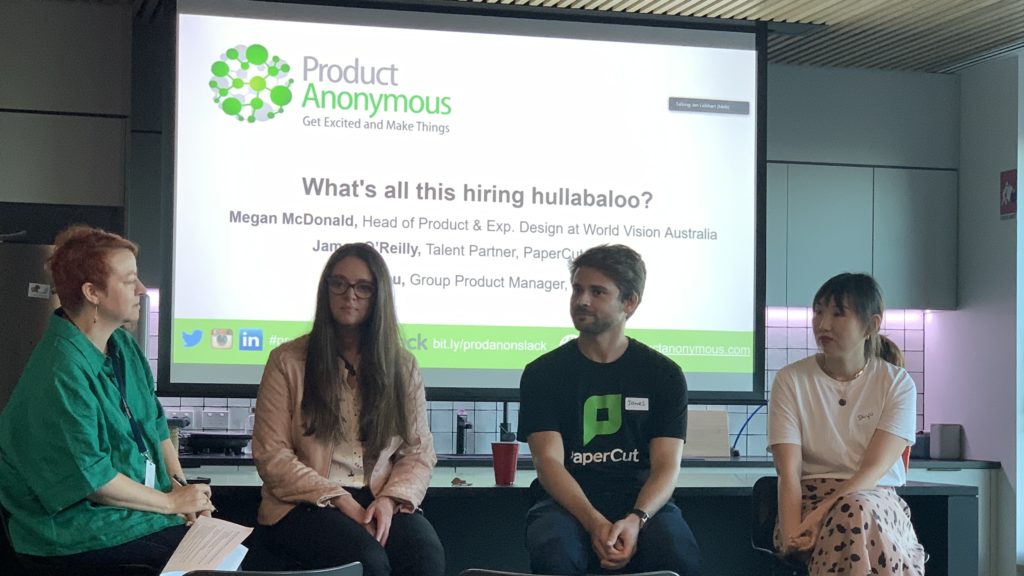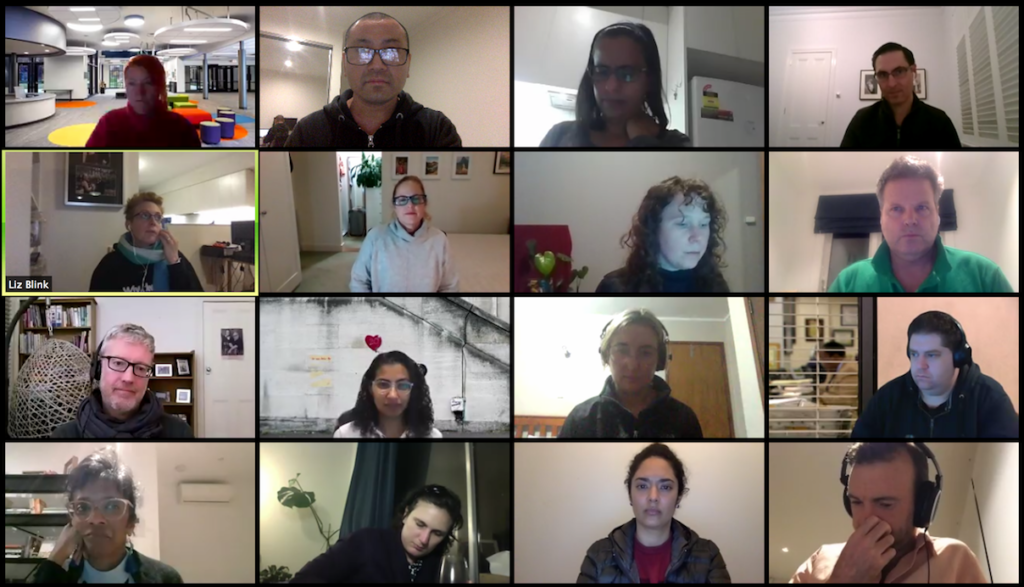As the environment continues to evolve, so does Product Anonymous, with our first hybrid event.
Over the past couple of years, many companies had to go into survival mode: pivot business models, apply recruitment freezes and even let people go. However, as the environment began to improve, and business confidence started to return, the (jobs) market reopened, with a lot of companies beginning to recruit again, seemingly all at the same time.
We were joined by Megan McDonald (Head of Product and Experience Design, World Vision Australia), James O’Reilly (Talent Partner, PaperCut Software) and Shiyu Zhu (Group Product Manager, Zendesk) for an Ask Me Anything panel session, talking about the state of recruitment and hiring, and the great resignation.

How has recruitment changed?
With so many other opportunities being so visible, the power dynamic between the candidate and recruiter has changed, and candidates know it.
Megan: Recruiters and hirers are now much more in sales pitch mode – ‘why you should want to work for us?’
James: It’s important to try to differentiate, and showcase the benefits of joining your company.
Megan: In the past, when working with both internal Talent Partners and external recruiters, both would often come back with many of the same candidates. Now, not so much.
How has the recruitment process changed?
James: Because Product Management is a mix of art and science, it can be difficult for a recruiter to recognise what makes a good product manager. Therefore it is as important as ever for Talent Partners and Recruiters to work closely with the hirers (ie, Internal Product Managers) to really understand their must haves. In the current environment, the nice to haves have become a luxury.
The candidate experience has also become incredibly important, which includes being responsive to queries, and the speed to progress through the process.
Shiyu: Zendesk adapted their approach. Rather than individual interviews with engineering, product, design and a VP, they started to combine some of them. As there was always some crossover, this allowed the to trim some of the fat.
Also, their take-home assignment became an in-interview case study to help understand how the candidate thinks and approaches business problems.
Megan: World Vision Australia have taken a more holistic view, not just focussing on recruiting, but extending to the onboarding process. They want to avoid candidates having post-purchase dissonance and regrets about not working somewhere else.
But are compressed interview processes all good?
James: Can the process be too short? Yes. With engineering, they went down to 3 stages, and some candidates said it was too fast, so they went elsewhere. Have empathy for the candidate, and check in with them around the process. Ensure they have adequate opportunity to tell you what they can bring, and why they are right for the job.
Shiyu: To remove people who are just good at interviews, and who may have practised the perfect answer to behavioural questions (such as, describe a time you dealt with conflict), Zendesk use case studies and business examples instead. This way they can get an insight to how the candidate thinks.
How can smaller companies compete with the finances of bigger players?
Shiyu: What is your value prop as an employer? How are you different? What can you offer? It doesn’t necessarily need to be monetary.
Megan: Consider how you invest in your people. Don’t limit your thinking to just what they need to do a good job, but also how they can grow their career.
Hiring is the easy part, how do you keep the talent you have?
James: There are many different aspects here:
- Onboarding: set the right expectations of the role.
- Recruiter handover: during the recruitment process, more than likely, the recruiter will be the one who has spoken to the candidate the most often and knows them best. So handing over any recruitment knowledge to the new manager, such as their motivation and goals, can help set them up for success.
- Impact: Allow candidates to understand what impact they can make.
- Exit process: When things don’t work out, the exit process is important, to learn why people are leaving, so you can identify what things may need to be changed.
Shiyu: A common misconception about a person changing jobs is that they will just be getting more money elsewhere. However, different people have different motivations:
- Title;
- Responsibilities;
- Visibility; or
- Earning more.
As a manager, give your team members the opportunity to be able to win. Set them up on their winning ways.
What areas do they want to develop? Have them do a self-assessment, and then start the conversation and create actionable items that they can use to progress. Giving them a goal, how they want to grow, and then continuously revisiting can help them see where’s next.
Megan: We’ve seen a higher proportion of people moving sideways internally. Attitudes are important, and you don’t necessarily need all the technical skills, those can be learnt.
What advice do you have for applicants?
James: Usually the first touch point will be with somebody in recruitment, and they won’t be able to understand how good you are at Product, as you need a Product Manager to be able to assess that. So, demonstrate to the recruiter how you are good (eg, display you’ve done your research, about the company, the roles, the industry, the products). You can also show in depth thought and knowledge through your cover letter.
Megan: Ask the smart questions, not just the short term and immediate outputs.
Shiyu: Some of the attributes that Zendesk looks for include a can-do attitude, the desire to build awesome products, and also a willingness to learn. And it is not just about hard skills, like defining a vision. Soft skills are just as important, like how you structure your responses in a logical manner, so that somebody can follow your thinking.
With the current market, are lots of short term roles a red flag still?
Shiyu: In San Francisco, job swapping was common. However, maybe a better perspective to apply is, does your current job give you the satisfaction you need, and the room to grow. If you have a history of changing jobs, the recruiter or hirer may ask you about it, so you need to be able to answer it, hopefully with a compelling reason.
James: This has become more common in the current climate because of the abundance of opportunities available. The explanation could be as simple as ‘the market was hot, and you saw an opportunity that unfortunately didn’t pan out’.
Any tips to progress product careers, from product owner to product manager to senior product roles?
Shiyu: Make sure you talk to your manager, don’t expect them to know without you telling them. Work through it together, and look for opportunities. Sometimes those other opportunities may be in other areas of the company.
Also, get involved with Communities of Practice *cough*Product Anonymous*cough*.
Thank you
Thank you again to all our panelists, Megan McDonald, James O’Reilly and Shiyu Zhu for sharing; to Chris Holmes, Michael Lambert and Nosh Darbari for helping on the night, to IntelligenceBank for hosting and to our zoom sponsor Pluralsight / A Cloud Guru.

